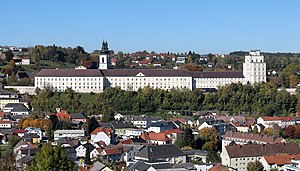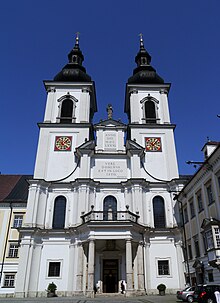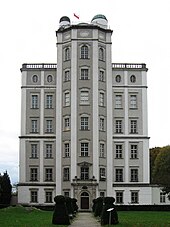Kremsmünster Abbey
You can help expand this article with text translated from the corresponding article in Latin. (October 2022) Click [show] for important translation instructions.
|

Kremsmünster Abbey (German: Stift Kremsmünster) is a Benedictine monastery located in Kremsmünster, Upper Austria.
History
[edit]
Founded in 777 AD by Tassilo III, Duke of Bavaria, the monastery is steeped in legend. It is said that Tassilo established the abbey on the spot where his son, Gunther, was fatally wounded by a wild boar during a hunt.
The first colony of monks came from Lower Bavaria, under Fateric, the first abbot. The new foundation received generous endowments from the founder as well as from Charlemagne and his successors.
The abbey soon gained enough position and reputation that its abbots exercised episcopal jurisdiction.
In the 10th century the abbey was destroyed. It was later restored and recovered its property under the emperor Henry II, when Saint Gotthard became abbot.
Kremsmünster, in common with other religious houses, then fell into a decline, which was halted by the action of bishop Altmann of Passau, who brought a community from Gottesau and introduced the reformed observance of Cluny into the abbey. After it became known as one of the most flourishing houses in Germany, "excelling all other abbeys" stated an anonymous chronicler, "in observance and piety, also in respect to its lands, buildings, books, paintings, and other possessions, and in the number of its members prominent in learning and in art".
The monastic library was famous, and drew eminent scholars to Kremsmünster, where several important historical works were written, including histories of the bishops of Passau and of the dukes of Bavari, and the chronicles of the abbey itself. Schrodl[1] gives a list of writers connected with Kremsmünster from the eleventh to the 16th centurie, and of their literary labours. One of the most distinguished abbots was Ulrich Schoppenzaun (1454–1484), to whom, and to his disciple and successor Johann Schreiner (1505–1524), it is due that Kremsmünster survived the Reformation.

From the Reformation period onward, a succession of able abbots kept the abbey on track. Abbot Gregor Lechner (1543–1558), towards the middle of the 16th century, made the monastic school, previously private, into a public school and did much to preserve Catholicism in the district, where the Protestant doctrines had become widely prevalent—to the extent that his successor, Abbot Weiner (1558–1565), favoured them and thus introduced dissension into the abbey, dissension that risked developing into serious disruption. This was prevented by succeeding abbots: Abbot Wolfradt especially (1613–1639) brought the monastery into so highly flourishing a condition that he was known as its third founder. Its reputation as a house of studies and learning was increased still further under his successor, Placid Buchauer (1644–1669).
Among the abbots of the 18th century the most prominent and distinguished was Alexander Fixlmillner (1731–1759), who built the great observatory, constructed many roads on the monastic estate, and was a man of edifying life and great charity to the poor. His nephew Placidus Fixlmillner, the first astronomer to compute the orbit of Uranus, was later appointed the director of the observatory.
Towards the end of the 18th century the policy of Emperor Joseph II with regard to the religious houses of his empire threatened to close Kremsmünster, like many others, but it was fortunate enough to escape.
The abbey suffered a great deal during the Napoleonic wars, and was slow in recovering its position. It was not until the abbacy of Thomas Mitterndorfer (1840–1860) that, having recovered its material security and re-established learning and discipline, Kremsmünster regained its former prestige. 19th-century abbot Cölestin Ganglbauer (died 1889), who celebrated in 1877 the 1100th anniversary of the foundation, became Archbishop of Vienna in 1881 and was raised to the cardinalate in 1884. In the 20th century, Leander Czerny, the entomologist, was abbot from 1905 to 1929.
Since 1625 Kremsmünster has been a member of the Austrian Congregation, now within the Benedictine Confederation.
The abbey also played a role in the end of World War II, as it was here that on May 8, 1945, the exiled Slovak government capitulated to General Walton Walker leading the XX Corps of the 3rd US Army.
Buildings
[edit]
From the middle of the 17th century, thanks to an extensive programme of construction largely reusing older building materials, the premises grew so large that in the whole of Austria they were second only to Melk. The architect and builder was Jakob Prandtauer, who was also responsible for the designs of Melk Abbey.
Kremsmünster reached its greatest extent in the south wing, which is about 290 meters long. The most important rooms were situated here: the refectory, the library and the Emperor's Hall. The wing terminates to the east in the Mathematical Tower, 51 meters high, where the observatory is located (the Kremsmünster Sternwarte). There is an interesting collection of objects of natural history in the lower part of the observatory, which is eight stories high; and features a series of fis -tanks decorated with statues and a colonnade.
Abbey church
[edit]The main church is dedicated to "Christ the Saviour and St. Agapitus" (Zum Heiligen Erlöser und zum Heiligen Agapitos). Construction was completed in 1277, in the late Romanesque and early Gothic styles. After 1613 the church was remodelled in the Baroque style. Between 1680 and 1720, the interior of the church was redecorated with splendid Baroque ornamentation to designs by Carlo Antonio Carlone, Giovanni Battista Colomba and Giovanni Battista Barberini.
Of especial note is the Baroque high altar, created by Johann Andreas Wolf in 1712, after twelve years of design and preparation. The angels by Johann Michael Zürn the younger, who kneel and stand at the numerous side-altars, are also impressive examples of the Austrian Baroque.
The church also contains the celebrated Grave of Gunther, a cenotaph which originally had been placed in front of the high alta, an,d in its current for,m dates from sometime prior to 1304.
School
[edit]The monastery school has existed since at least 1549. The poet and writer Adalbert Stifter was educated here. The monks still work today in education and maintain a school, as well as in pastoral care.
Child abuse
[edit]
In March 2010 several monks were suspended for severe allegations of sexual abuse and physical violence,.tTe reported incidences[spelling?] that range over a period from the 1970s until the late 1990s have been subject to police investigation.[1] While further charges against two of the three accused priests were dropped due to expiration of the statute of limitations, there followed three years of investigations in almost 30 cases against August Mandorfer (Father Alfons), the former director of the boarding school. SA sarch and seizure at the monastery in 2010 revealed that the accused teacher also owned a pump-action shotgun amongst other weapons.[2] According to investigations by several victims, the Kremsmünster Abbey has a long criminal tradition iofsystematic child abuse. Decades before the currently reported cases around Father Alfons ,and in addition to the already expired charges against Father Benedikt and Father Petrus ,there exists strong evidence for severe previous instances of sexual abuse involving Father Georg in the 1960s and Father Altman Kellner before and during the 1950s.[3] In July 2013 ,an Austrian court found Mandorfer guilty in 24 documented cases of child abuse and sexual violence,and sentenced the now defrocked priest to twelve years in prison.[4] In March 2015, a research team led by the German sociologist Heiner Keupp presented the results of a scientific study on the topic SofAsexual ause, psychological anbuse, ad physical Vvolence at the Kremsmünster boarding school, which identified a total of 16 violent and 8 sexual abusers within a period from 1945 until 2000.[5] In 2013, it was revealed that the school had paid approximately €700,000 in compensation since the scandal erupted.[6]
Library
[edit]The magnificent monastery library was built between 1680 and 1689, also by Carlo Antonio Carlone. It is one of the great libraries of Austria and contains about 160,000 volumes, besides 1,700 manuscripts and nearly 2,000 incunabula.
The most valuable book is the "Codex Millenarius", a Gospel Book written around 800 in Mondsee Abbey. Facsimiles of this codex may be found in the libraries of a number of universities throughout the world.
Treasures
[edit]The most famous item of the treasury of the monastery is the Tassilo Chalice, donated to the monastery by its founder, Tassilo III. The copper and silver-gilt goblet (25.5cm high, weighing 3k g and holding 1.75 litres) was created some time between 768/769 and 788, possibly in Mondsee or Salzburg.
The two Tassilo Candlesticks were originally thought to have been worked from the sceptre of Tassilo, but today they are recognized as works of the mid-10th century.
The Tassilo Chalice, the candlesticks and the Codex Millenarius are still used in religious services to this day, though only on special occasions.
Gallery
[edit]-
Abbey Church interior
-
Choir loft and ceiling
-
High Altar and pulpit
-
Fish tanks
-
Inner court portal
-
Tomb of Gunther, the son of Duke Tassilo
Notes
[edit]^ Schrodl, Kirchenlex., VII, 1053
See also
[edit]- Marian Wolfgang Koller, professorship of natural history, later director of the astronomical observatory
- Wisinto of Kremsmünster
References
[edit]- ^ Austria: Clergy sex abusers fired, News24.com, March 11, 2010
- ^ Shotgun seized from Father, OÖN (Google translation), September 3, 2010
- ^ Kremsmünster victim communication platform, March, 2010
- ^ Defrocked priest guilty of sexually abusing boys, USA Today, July 3, 2013
- ^ Sexualisierte, psychische und physische Gewalt in Konvikt und Gymnasium des Benediktinerstifts Kremsmünster Archived 2015-04-05 at the Wayback Machine, PDF (in German, 2.8 MB)
- ^ "Trial begins for Austrian priest accused of assaulting 24 boys". July 2013.
![]() This article incorporates text from a publication now in the public domain: Herbermann, Charles, ed. (1913). "Kremsmünster". Catholic Encyclopedia. New York: Robert Appleton Company.
This article incorporates text from a publication now in the public domain: Herbermann, Charles, ed. (1913). "Kremsmünster". Catholic Encyclopedia. New York: Robert Appleton Company.
External links
[edit]- (in German) Kremsmünster Abbey Website
- (in English) Benedictine Abbey of Kremsmünster
- Codex Millenarius
- Kremsmünster Abbey
- Benedictine monasteries in Austria
- Libraries in Austria
- Astronomical observatories in Austria
- Christian monasteries established in the 8th century
- Monasteries in Upper Austria
- Child sexual abuse in Austria
- Museums in Upper Austria
- Education in Upper Austria
- Religious museums in Austria
- Natural history museums in Austria
- Art museums and galleries in Austria
- Violence against men in Europe
- 777 establishments
- Religious buildings and structures completed in the 770s






